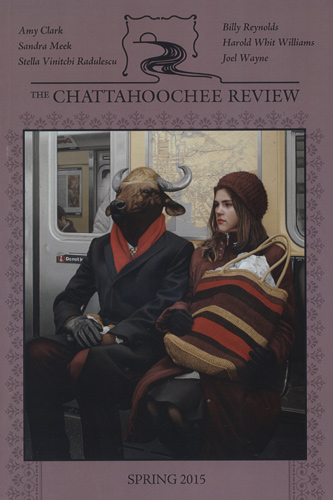The Chattahoochee Review – Spring 2015
The Chattahoochee Review is published quarterly in paperback by Georgia Perimeter College, located in Decatur, near Atlanta. According to their website, “our roots are in the South,” but the review publishes work from all over the world, in all genres. The Chattahoochee Review is published quarterly in paperback by Georgia Perimeter College, located in Decatur, near Atlanta. According to their website, “our roots are in the South,” but the review publishes work from all over the world, in all genres.
The Spring 2015 issue leads with the winners of the Lamar York Prizes, one in fiction and one in nonfiction. “Brother’s Keeper” by Joel Wayne is a sentimental short story that traces twin brothers Doc and Jacob from 1978, when they were placed in a foster home and sexually abused, to 2009, when Jacob is dying of cancer somewhere in the Midwest and Doc is flying to visit his brother in the hospital. Nonfiction winner “The Rocks” by Amy Clark investigates a group of overgrown gravestones on a farm in Lee County, the farthest western point of Virginia, a remote triangle of Appalachia. The stones may date from before the Civil War, and they may mark the graves of free black sharecroppers. Clark explores a local myth: white people who claim Cherokee ancestors have genes from Africa. The piece offers much in the way of atmosphere: “The woods are hushed, as if the trees and birds are holding their breath.”
The issue has five other stories. “Mary Toft of Hayden Park High School” by Jessica Lilien is a sly satire on teenage pregnancy, the American health care system, the tabloid press, and female empowerment. The narrator, now a successful attorney in her thirties, tells how at age fifteen she gave birth to a litter of nine rabbits. The tone is deadpan, with painstaking medical and legal jargon, and the effect is hilarious. The other four stories are realistic slices of life, pleasant and suggestive.
Eighteen poems by thirteen poets fall into a conventional free-verse type: short lyric poems with a few visual images, for example a yellow jacket bee, turkey buzzard, or “a molded green ring of Jell-O.” The language is clear, but the mood is enigmatic, as if the poet could not settle on a meaning for the image. “You Wanted Peaches” by Kelly Jean White is a brief anecdote in which “you” never plants a peach tree, so at the end, “What I have is a scraggly wild rose bush / and a broken clothes pole.”
Four pieces of nonfiction are indistinguishable from the fiction in style, though more interesting in subject. “Speak English, Please” by Scott Russell Morris describes a year in which he and his wife teach English in an elite school in Kazakhstan, where they bow to political reality instead of grading fairly. “Murky Waters” by H. Ransom draws a contrast between the danger of rafting the wild rivers of West Virginia and the danger of drinking the polluted water.
“What’s Imagined is Real” by Harold Whit Williams is an interview with Robert Harrison, a poet, songwriter and performer in the band Cotton Mather. Mostly bland, the piece does offer this insight: “Robert and I have both stood by and watched as Austin, Texas, our dazed and confused little Slackerville, has become a modern, bustling American metropolis,” giving flavor to the journal’s Southern roots.
The issue closes with four book reviews. Informative and persuasive, each reviewer makes a case for why the book matters. On True Stories, Well Told: From the First 20 Years of Creative Nonfiction Magazine, Mary Makofske writes: “The evolution of creative nonfiction and even its name have been controversial . . . a genre that goes beyond reporting a story.” That is as critical as she gets, on a topic that confuses many writers. She concludes: “It will no doubt continue to experiment and innovate,” a fitting wrap-up for an issue with such strong nonfiction, although all genres included have their merits.
[www.thechattahoocheereview.gpc.edu]





